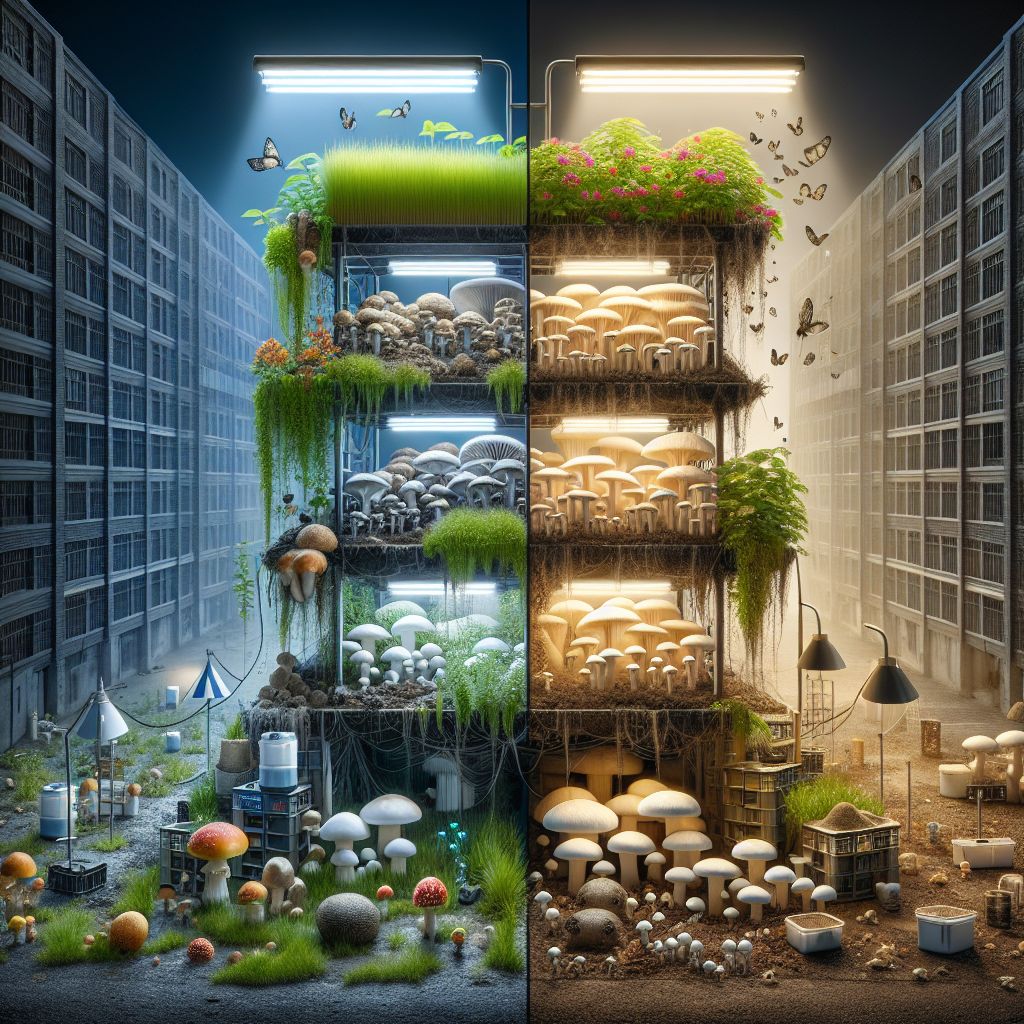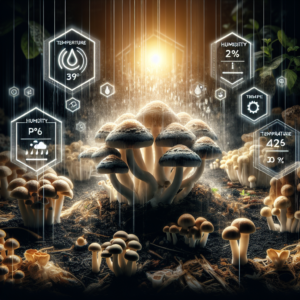
Key Takeaways: Solving Urban Mushroom Farming Problems
- Mushroom farming in urban areas requires innovative solutions to address space constraints, contamination, and climate control.
- Contamination is a major challenge, but can be managed with strict hygiene practices and careful substrate preparation.
- Optimal moisture levels are critical for mushroom growth, and proper techniques can help manage hydration without overdoing it.
- Vertical farming and selecting the right location are key strategies for space optimization in urban environments.
- By choosing environmentally friendly substrates and preparing them correctly, urban mushroom farmers can ensure healthy growth and sustainability.
Peeking Behind the Garden: The Urban Mushroom Dilemma
Urban mushroom farming is like a dance, a delicate balance of environment, care, and the right moves to cultivate something truly wonderful. But, even the best dancers can stumble, especially when the stage is as challenging as a bustling cityscape. Let’s explore the innovative world of urban mushroom farming and the challenges that come with it.
The Essentials of Urban Mushroom Farming
Before diving into the challenges, let’s establish the basics. Urban mushroom farming involves growing mushrooms in a city environment where space is at a premium, and resources must be used efficiently. It’s an excellent way to produce food locally and sustainably. You can grow mushrooms in containers, bags, or even repurposed furniture. The key is to create a micro-environment that mimics the natural conditions mushrooms love: moist, dark, and full of nutrients.
Spotting the Trouble: Common Urban Mushroom Farming Challenges
Now, let’s get to the heart of the matter. Urban mushroom farmers face a unique set of challenges. Space is tight, contamination risks are high, and the urban climate can be unforgiving. But don’t worry, for every problem, there’s a solution waiting to be discovered.
Gearing Up for Growth: Tackling Contamination Concerns
One of the most pressing issues in urban mushroom farming is contamination. It’s the uninvited guest that can crash your mushroom party. Contamination comes in many forms – bacteria, mold, and competing fungi – all eager to feast on your mushroom’s dinner plate.
Understanding Contamination Culprits
Contamination can sneak in through the air, on tools, and even on you. It’s a crafty opponent, but not unbeatable. You’ll know it’s there when you see strange colors or smells in your mushroom setup. It’s like a red flag saying, “Hey, something’s not right here!”
Strategies for Sterile Workspaces
To keep contamination at bay, cleanliness is your shield and sword. Here’s what you need to do:
- Sanitize your hands and tools before handling your mushrooms or substrate.
- Use a disinfectant to wipe down surfaces in your growing area regularly.
- Consider using a HEPA filter to clean the air entering your grow space.
These steps are your first line of defense against the invisible invaders trying to spoil your crop.
Space Optimisation: Making the Most of Urban Areas
Space is like gold in the city; it’s precious and needs to be used wisely. For urban mushroom farmers, making the most of every square inch is not just smart—it’s essential for survival. The goal is to create a productive mushroom farm without needing a sprawling field or a vast warehouse.
That’s where innovation kicks in. By rethinking the traditional farming model, urban mushroom growers are turning small spaces into gold mines of productivity. From repurposing old buildings to transforming rooftops, the urban landscape is ripe with opportunities.
Choosing the Right Location
Location, location, location—it’s as true for mushrooms as it is for real estate. When scouting for a spot, you’re looking for more than just space. You need a place that’s sheltered from direct sunlight and pollutants, yet still accessible for maintenance and harvesting. Basements, garages, and even closets can become your mushroom haven if they meet these criteria.
Vertical Farming: Layering for Efficiency
Think up, not out! Vertical farming is a game-changer for urban mushroom cultivation. It involves stacking growing shelves or using hanging bags to maximize vertical space. This approach not only increases your yield per square foot but also makes monitoring and harvesting your mushrooms easier.
Imagine a bookshelf, but instead of novels and memoirs, it’s lined with oyster mushrooms. Each shelf is a chapter in your urban farming story, waiting to be read.
Substrate Solutions: Sourcing and Sterilization
The substrate is the bread and butter of mushroom farming. It’s what your mushrooms will call home and draw nutrients from. In urban settings, sourcing and preparing the right substrate is a challenge that requires creativity and environmental consciousness.
Environmentally Friendly Substrate Options
Urban farmers are the MacGyvers of agriculture, turning waste into wonder. You can use coffee grounds, sawdust, or agricultural byproducts as substrates. These materials are often readily available in cities and can be sourced from local businesses looking to dispose of their waste sustainably.
For example, a coffee shop’s spent grounds can be the perfect base for growing gourmet mushrooms. It’s a win-win: the shop reduces waste, and you get a high-quality substrate for free or at a low cost.
By choosing environmentally friendly substrates, you’re not just growing mushrooms; you’re also contributing to a greener, more sustainable city.
Dialing in Substrate Preparation
Prepping your substrate is a bit like cooking—it needs just the right touch. Sterilization is crucial to kill any unwanted bacteria or fungi that might compete with your mushrooms. You can use methods like pasteurization, steaming, or even chemical treatments to get your substrate ready for action.
Remember, the cleaner your substrate, the happier your mushrooms will be. So don’t skip this step—it’s the foundation of your urban mushroom farm.
Adjusting for Climate: Beat the Heat and Cold
Weather in the city can be as unpredictable as a rush-hour traffic jam. But mushrooms, they like consistency. Too hot or too cold, and they’ll protest by not growing. That’s why climate control is a big deal for urban mushroom farmers.
Insulating Against Temperature Extremes
Insulation is your ally against the whims of weather. It helps maintain a steady temperature in your growing area, which mushrooms love. You can use insulating materials like foam boards or reflective sheets to keep the heat in during winter and out during summer.
Cooling and Heating Systems for Year-Round Production
With the right cooling and heating systems, you can turn your urban mushroom farm into a year-round operation. Portable air conditioners, space heaters, and even simple fans can help regulate the temperature. The key is to monitor the environment closely and adjust as needed to keep those mushrooms comfy.
Think of it as creating a microclimate, a little bubble where it’s always mushroom season, no matter what’s happening outside.
Pest Control: Keeping Critters at Bay
Pests are the uninvited guests that don’t know when to leave. In an urban setting, you might deal with anything from fruit flies to mites, all looking to nibble on your hard work.
Identifying Common Urban Farming Pests
Knowing your enemy is half the battle. Common pests in urban mushroom farms include fungus gnats and thrips. These tiny troublemakers can wreak havoc if left unchecked. But with a keen eye and regular inspections, you can spot them before they become a real problem.
Keep an eye out for telltale signs of pests, like small flies around your mushrooms or bite marks on the caps and stems. If you see these, it’s time to act.
Organic Methods for Pest Management
When it comes to pest control, harsh chemicals are a no-go. They can harm your mushrooms and the environment. Instead, opt for organic methods like introducing beneficial insects, using sticky traps, or applying natural repellents.
For example, nematodes are microscopic worms that can help control fungus gnat larvae in the substrate. They’re like tiny warriors, defending your mushrooms from the shadows.
By staying vigilant and using organic pest control, you’re not just protecting your crop; you’re also keeping your urban farm safe and sustainable for the future.
Scaling Up: Transitioning from Hobby to Business
So, you’ve mastered the art of urban mushroom cultivation and are thinking, “What’s next?” Scaling up, that’s what! Transitioning from a hobby to a business is like leveling up in a game. It’s exciting, but there are new challenges to face and bosses to beat – in this case, the market and business logistics.
The key to success is planning. You’ve got to understand the costs, the competition, and most importantly, your customers. It’s not just about growing mushrooms anymore; it’s about growing a brand and a business that stands out in the urban jungle.
Planning for Profit: Business Models to Consider
When you’re planning to scale up, you need to think about the best business model for your urban mushroom farm. Here are a couple of options to consider:
- Direct-to-consumer sales: Set up a stand at your local farmer’s market or sell directly to neighbors and friends. This model allows for higher profit margins but requires more effort in marketing and sales.
- Wholesale to restaurants and grocers: Partner with local businesses that are interested in sourcing quality, local produce. They might order in larger quantities, which means steady business for you.
Remember, each model has its pros and cons, and the right choice depends on your goals, resources, and the demand in your area.
Marketing Your Urban Mushroom Farm
Marketing is how you’ll get the word out about your mushrooms. Start with a compelling story about your farm – maybe it’s about sustainability, or perhaps it’s about bringing fresh, gourmet mushrooms to the urban table. Use this narrative to connect with customers on social media, at local events, and through word-of-mouth.
Create eye-catching packaging and consider offering samples. Let people taste the quality of your mushrooms, and they’ll be more likely to buy. And don’t forget about branding. A memorable name and logo can go a long way in making your mushrooms stand out in a crowded market.
And one more thing – get feedback. Talk to your customers and learn what they love about your mushrooms and what you can do better. This will not only improve your product but also build stronger relationships with your customers.
FAQ: Your Urban Mushroom Farming Questions Answered
You’ve got questions, and I’ve got answers. After all, knowledge is the best tool in any urban farmer’s toolkit. Here are some of the most common queries I come across:
What are the best mushroom species for urban farming?
When it comes to urban mushroom farming, some species are better suited than others. Oyster mushrooms are a popular choice because they’re relatively easy to grow and have a high yield. Shiitake mushrooms are also a good option, especially if you’re looking for a mushroom with a longer shelf life. But the best species for you will depend on your climate, your setup, and the tastes of your local market.
It’s a good idea to start with one species and get really good at growing it before adding more varieties to your lineup. This way, you can ensure the quality of your mushrooms and build a strong reputation.
How can I start an urban mushroom farm on a tight budget?
Starting on a shoestring budget is all about resourcefulness. Use what you have or can get for free. Reach out to coffee shops for spent grounds, use buckets or bags for containers, and look for free or cheap sources of spawn. Remember, it’s not about how much money you have; it’s about how creatively you can use your resources.
Also, start small. You don’t need a huge operation to begin with. A small, well-managed mushroom farm can produce a surprising amount of mushrooms. As you sell your product and learn the ropes, you can reinvest your profits into expanding your farm.
What are the signs of healthy mycelium growth?
Healthy mycelium is the foundation of a successful mushroom crop. It should look white and fluffy, like a layer of snow covering your substrate. If you see any colors like green, black, or yellow, that’s a sign of contamination. The mycelium should also smell earthy and fresh. If it smells sour or off, that’s another red flag.
Watching your mycelium grow is like watching a city come to life. Each strand is a road, each cluster a neighborhood, all working together to create something beautiful.
Can mushroom farming be organic and sustainable in an urban environment?
Absolutely! Urban mushroom farming is one of the most sustainable forms of agriculture. It uses waste products as substrate, requires very little water, and doesn’t need pesticides or herbicides. Plus, by growing food where it’s eaten, you’re reducing the carbon footprint associated with transportation.
To keep your urban mushroom farm organic, use organic substrates and avoid chemical sterilizers. Stick to natural methods for pest control and disease management. Your mushrooms will be healthier for it, and so will your customers.
How do I handle oversaturated markets for common mushroom varieties?
If your local market is already full of common mushroom varieties, it’s time to think outside the box. Consider growing specialty mushrooms that are harder to find. You could also focus on the story behind your mushrooms – maybe they’re the freshest, or maybe you’re using innovative, sustainable farming techniques.
- Research the market to see what’s missing.
- Connect with chefs and foodies who might be looking for something different.
- Offer mushroom growing workshops or farm tours to engage with your community.
In a saturated market, differentiation is key. Find what makes your mushrooms unique, and shine a spotlight on it.
Urban mushroom farming is an adventure, one that requires patience, creativity, and a willingness to learn. But the rewards – fresh, delicious mushrooms, a sense of community, and the joy of growing food in unexpected places – are worth every challenge. So roll up your sleeves, get your hands a little dirty, and join the urban farming revolution. Your city and your taste buds will thank you.


